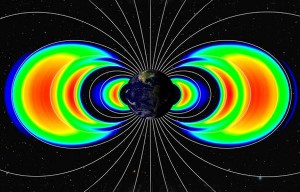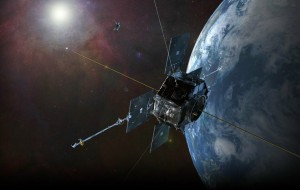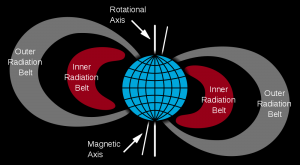
A new radiation belt has been discovered around Earth. It is shown here using actual data as the middle arc of orange and red of the three arcs seen on each side of the Earth. (Image: JHUAPL/LASP)
NASA scientists have discovered a third radiation belt briefly surrounded Earth for about a month before being blasted away by an interplanetary shock wave from the sun.
Experts had long thought there were only two distinct regions of trapped radiation. But the third ring was spotted by twin Van Allen radiation probes NASA launched in 2012 to study the radiation belts which encircle Earth and can be hazardous to orbiting satellites and astronauts.
“This is the first time we have had such high-resolution instruments look at time, space and energy together in the outer belt,” said Daniel Baker from the University of Colorado in Boulder, who is lead author of the study. “Previous observations of the outer radiation belt only resolved it as a single blurry element. When we turned REPT [the Relativistic Electron Proton Telescope] on just two days after launch, a powerful electron acceleration event was already in progress, and we clearly saw the new belt and new slot between it and the outer belt.”
According to mission scientists, the discovery demonstrates radiation belts are dynamic and flexible in nature, which provides a better understanding of how they respond to solar activity.
However, the discovery might not have occurred had scientists followed standard operating procedures.

Artist rendering of the twin Van Allen probes in orbit within Earth’s magnetic field. (Image: JHU/APL)
Anxious and excited mission scientists turned on a critical piece of equipment soon after it was launched into space aboard the probe. Usually, standard operating procedures for most NASA science missions call for a waiting period that can take months. After that, instruments are slowly turned on and activated one at a time, as technicians slowly ramp them up to full power.
If scientists working with the Van Allen probes mission had followed that set of procedures, the third Van Allen belt might never have been spotted. Data sent back to Earth from the probes throughout the month of September at first showed the two expected Van Allen belts.
But a few days later, the scientists noticed the belt’s outer ring seemed to be squeezing into an intense, tightly packed band of electrons and that a third, less compact belt of electrons formed further out, creating a total of three rings.
Named after the noted physicist, James Van Allen, the man who discovered them in 1958, the Van Allen radiation belts are two, and now sometimes three, layers of trapped radiation from solar winds or cosmic rays held in place by Earth’s magnetic fields.
Earth’s magnetic fields, which come from our planet’s inner core, repel most harmful radiation away from us, keeping it high above Earth where it accumulates in the Van Allen belts.
These layers of radiation are greatly affected by space weather and expand and contract depending upon the amount of energy sent to Earth from the sun and elsewhere.
The Van Allen belts can extend into space from an altitude of about 1,000 to 60,000 kilometers above the Earth’s surface. The belt closest to Earth is called the inner belt. It’s separated from the outer belt by an empty region of space. This gap between the two Van Allen belts is caused by low-frequency radio waves that eject energy particles which would otherwise accumulate there.
Scientists have said there are times, when the sun erupts, that particles force their way into the gap, but soon disappear after a few days.
The Van Allen probes mission includes two spacecraft packed with identical instruments so that simultaneous measurements can be taken from different locations within the radiation belts.
“The fantastic new capabilities and advances in technology in the Van Allen Probes have allowed scientists to see in unprecedented detail how the radiation belts are populated with charged particles and will provide insight on what causes them to change, and how these processes affect the upper reaches of Earth’s atmosphere,” said John Grunsfeld, NASA’s associate administrator for science.
Van Allen Probes Discovery – NASA Video






















Van Allen DID NOT discover the belts.
He merely suggested they put a geiger counter on the explorer sat.
A fella by the name of Nicholas Constantine Christofilos suggested the belts surrounded the earth.